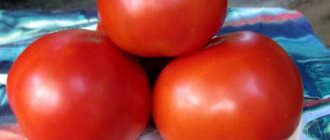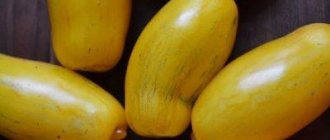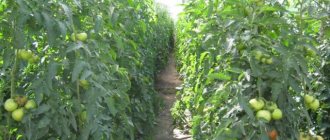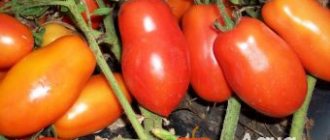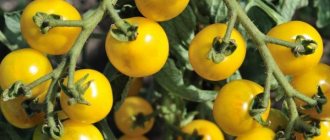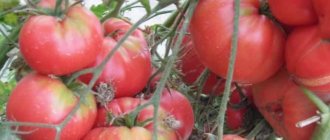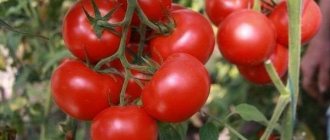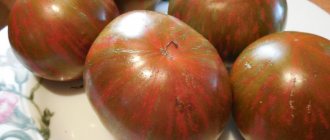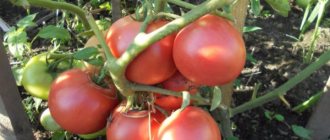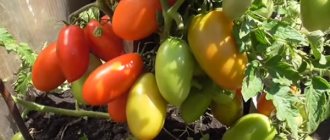The unpretentious early hybrid Baron f1 will appeal to those who have not yet mastered all the intricacies of tomato agricultural technology. He will “forgive” some of the mistakes of inexperienced gardeners and will be one of the first to delight you with delicious tomatoes. The tomato resists temperature changes and diseases.
| Height | Landing location | Ripening time | Fruit color | Fruit size | Origin | Fruit shape |
| short | Greenhouse, Open ground | Early ripening | Reds | Average | Hybrid | Flat-round |
Description
"Baron" is a determinate plant of standard type. The height of the bush does not exceed 60–70 cm. The strong trunk can withstand the weight of the fruit. Doesn't break at the slightest touch. The growing season lasts from 90 to 95 days. Tomatoes ripen in clusters. 5-6 pieces on each.
The first flower cluster is placed above the 6th–7th leaf. The next ones are formed in 1–2. The color of the green mass and trunk is bright green. The tomato is dark red. The yield reaches 18 kg per 1 m2. It is universal in use. Suitable for preparing vegetable dishes from fresh fruits or for winter preparations.
The variety bears fruit best in open ground in the south of the country. It is recommended to cover the tomatoes in the central strip with film. In Siberia or the Urals they can only be grown in a greenhouse.
Advantages and disadvantages
Pros:
- The fruits on the cluster are approximately the same size, quite large.
- Can be used to produce early tomatoes for commercial use.
- Quite a productive tomato.
- Resistant to fluctuating weather conditions.
- Excellent immunity to a number of major diseases.
- Possibility of transportation over long distances.
- Perfectly stored.
- High commercial varietal qualities.
Minuses:
- During the growth stage, the watering regime must be strictly observed.
- If you do not purposefully engage in the formation of a bush, it will quickly end, give up the harvest and stop the growing season.
- Seeds must be purchased from the manufacturer every year.
Photo of tomato "Baron"
Description of the variety
Determinate bushes stop growing at 70-80 cm. The foliage is high. The standard stem ensures good stability of the bush until the technical ripening of the fruit. The first tassel is tied over the 7th leaf.
Fruit
Tomatoes fully ripen 90-100 days after sowing. The shape of the fruit is traditional round. The skin color is bright red.
Other features of tomatoes:
- Average size – 150-170 grams, maximum – 250 grams;
- The fruits are proportional and ripen together;
- From 4 to 6 seed chambers;
- Increased dry matter content - about 5.5%.
Features of cultivation
Seeds are sown for seedlings in early March. Leave in a warm place covered with film until germination. Then move the container to a well-lit place. Regularly loosen and water through a strainer with warm water.
In the phase of 1-2 leaves they dive. Transplanted to a garden plot at the age of 50 days, when night frosts stop and the soil warms up. Although the variety is quite tolerant of low temperatures.
As the bush grows, it is formed into 1–2 stems and tied up. Supports are placed under the branches. Water only after sunset with warm, settled water.
Before the fruits begin to ripen, fertilizing is carried out with mineral complexes with:
- nitrogen;
- magnesium;
- potassium;
- phosphorus.
Foliar feeding with magnesium, boron and manganese stimulates fruiting and flowering and accelerates ripening.
If you follow agricultural practices, you can not be afraid of diseases. But no one is immune from the appearance of pests:
- You can get rid of spider mites using a soap solution;
- slugs are driven away by ammonia solution and soil azolation;
- The Colorado potato beetle is destroyed by the drug "Prestige".
Regular ventilation of the greenhouse, removing weeds and loosening will help to avoid problems.
The process of growing and caring for tomatoes in a greenhouse
Most often, tomatoes are grown in greenhouse conditions, so we will consider the main stages of cultivating a plant on protected ground.
- Initially, you need to prepare a greenhouse where seedlings will be grown, and then adult plants will be cultivated.
- dig up the ground, level all the piles, make the soil as light as possible;
- add humus and peat. These elements will saturate the soil with nutrients and make it looser;
- treat the soil with disinfectants. There are a lot of pathogenic bacteria in the soil after winter; in order to protect plants from their attacks, you need to use one of the modern biological preparations, for example, Fitosporin, Glyokladin, Alirin-B.
- A few days before sowing, you need to prepare the planting seeds.
- check them for germination. Dissolve a small amount of salt in a glass of water and place the seeds. Good seeds will sink to the bottom (which means they have a full endosperm), empty ones will float to the surface;
- To stimulate germination, treat the seeds with a growth stimulant. You can use the drug "Energen", which increases germination and predisposes the plant to active growth. To soak 10 grams of seeds, you will need 50 ml. dissolve 8-10 drops of the drug in water, soak the seed for 6 hours.
- Sowing seeds:
- make small grooves, 2 cm deep;
- water the soil with warm water (let it soak well);
- place the seeds at a distance of 2 cm from each other;
- Sprinkle with a 1 cm layer of soil, pour warm water again.
- Greenhouse climate:
- the air temperature for normal seedling growth is +23-26 degrees;
- air humidity 60-65%.
- Replanting and caring for plants:
- transplant tomatoes into separate holes 40-50 days after germination;
- the holes need to be fertilized with mineral fertilizer (1 teaspoon per hole), water them generously with warm water;
- Place 3 plants per square meter;
- Adult tomatoes need to be watered once every 5-6 days;
- To reduce the evaporation of moisture from the soil, mulch it. Covering the soil will keep the root system warm and not overheat, which will contribute to the active growth of the plant;
- 20 days after planting the seedlings, in order to strengthen the plants, they can be sprayed with the Epin-Extra growth stimulator. The working solution is prepared from one ampoule of the drug and 5 liters of water. It is necessary to spray tomatoes only in the evening;
- Pests rarely appear in a greenhouse, but it is still worth monitoring the condition of the plants;
- In order for the fruits to ripen faster, after the tomatoes have formed (technical ripeness), they can be sprayed with a solution based on regular iodine. Dissolve 5-6 drops of iodine in 5 liters of water and treat the green mass of the plant along with the fruits.
Diseases and pests
There are a large number of varieties of diseases found in nightshades. Among the most dangerous are blossom end rot, Alternaria blight and the most common - late blight.
Important ! Overmoistening of the soil is the most common cause of disease.
The Black Baron variety is quite resistant to diseases and has good immunity, but preventive measures will not hurt at all. Let's consider the main causes and methods of preventing diseases.
Apical rot
The first sign of the disease is the appearance of watery spots on the tomatoes, which quickly grow and acquire a brown tint. The main causes of blossom end rot are temperature changes and lack of calcium in the soil. Excess nitrogen and high humidity also increase the likelihood of disease development.
For treatment, the leaves of the diseased plant are treated with a solution of calcium chloride.
Adding calcium as part of complex mineral fertilizers will be a good preventative measure.
Alternaria blight
Signs of the development of Alternaria include the appearance of small (up to 1 cm in diameter) dry gray spots. They appear first on the lower leaves. The disease then progresses and spreads to the entire plant.
A diseased bush will have to be treated with fungicides (for example, Kuproksat, Infinito).
Prevention of the disease consists of disinfecting the seeds and soil before planting, for example, with a strong solution of potassium permanganate.
Late blight
The causative agent of late blight is a fungus that first settles on the leaves in the form of grayish-brown spots and then consumes the entire plant.
When humidity is high, fluffy plaque grows. After spots appear on the fruit, the tomato rots. The main factors for the development of the disease are temperature changes, high humidity and rainy weather. On sunny days the disease is rare.
Late blight will be slowed down in the early stages only by fungicides (chemical: “Bordeaux liquid”, “Ridomil”; biological: “Fitosporin”, “Ecosil”) and the removal of affected leaves, and in the advanced stage - the entire plant.
As a preventive measure:
- regularly spray the bushes with fungicides (for example, biological) as soon as the temperature drops below +15 degrees;
- remove and burn diseased leaves;
- pick green fruits for ripening.
For disinfection, the removed fruits are kept for 1-2 minutes in water at a temperature of 60 degrees.
Pros and cons of the variety
The Black Baron variety is a hybrid variety, and therefore has some disadvantages. The main disadvantage that causes problems for inexperienced gardeners is the need to form a bush. Another disadvantage of this variety is the fragility of the branches, which require mandatory support. In addition, for good yield, tomatoes must be constantly fertilized.
However, the positive properties of the plant successfully compensate for these minor difficulties:
- Tomatoes are well transported; they can ripen in the room without losing any of their taste.
- An excellent table variety suitable for canning, it is good for juices and sauces;
- The fruits are very tasty and sweet;
- The plant is more hardy than red varieties and is less afraid of pests.
Today, chokeberry tomato seeds are no longer exotic; they are quite accessible to every gardener; the only question is choosing the right variety. If you decide to choose the Black Baron variety, you will definitely not be disappointed in it.
Growing
The variety is suitable for growing in greenhouses and open ground. Sowing of seedlings should be done in March - April to a soil depth of 1.5-2 centimeters. Picking is carried out when 1-2 permanent leaves grow. Before planting in a permanent place of growth, seedlings are hardened to resist temperature changes. Tomatoes are planted in a greenhouse in April, and in an open bed - when the frost subsides and the daytime air temperature reaches +18 degrees.
Seedlings are planted three per 1 square meter. With proper care, this variety produces an excellent harvest of tasty, juicy, strong tomatoes. Description of the basic rules for caring for the variety.
See also
Characteristics and description of the Bonsai (Banzai) tomato variety, cultivation and yieldRead
Black tomatoes: description
Of course, speaking about the main characteristics of such tomato varieties, one cannot fail to note the unusual coloring of the fruit. The taste is also somewhat different from the tomato varieties we are used to. In terms of taste, the fruits are more piquant and have an interesting aftertaste.
In addition to all this, such varieties in their chemical composition contain many substances and vitamins that are very useful for the human body. The same anthocyanins, which are largely responsible for the unusual color of fruits, have a beneficial effect on the functioning of the gastrointestinal tract, they have a rejuvenating effect.
Such tomatoes are indicated for people who have vision problems. These tomato varieties have an unusual balance of acidity and sweetness. The sweetness of such fruits is special, and spices and even fruit tones are clearly felt in the aftertaste.
Detailed description
This variety is classified as indeterminate, which means that under favorable climatic conditions the bush is capable of reaching a height of about two to three meters, producing about 50 clusters! It should be said that tomatoes of this type do not necessarily have to wait for ripeness on the bush; the fact is that they can grow in a dark place. The main condition is that it must be dry.
The “Black Baron” tomato was included in the State Register of Breeding Achievements of the Russian Federation in 2010. It is noted that this plant can be grown throughout the country. True, in some regions of Russia the “baron” will feel good only in greenhouses.
During its growth, the “black baron” reaches quite large sizes, its stems become denser, and its leaves become so large that they require frequent formation. Bushes should be tied to strong and reliable supports. During flowering, large flowers of rich yellow color appear on the plant.
Characteristics of tomatoes
Early ripening determinate tomatoes, bred for cultivation in the middle and southern climatic zones. It takes about 90-100 days from planting the seeds in the ground to the ripening of the fruits.
The brush begins to grow after the 7th permanent leaf. Multi-leaved, requires thinning of leaves when grown. Resistant to popular diseases, such as verticillium, tobacco mosaic, cladosporiosis.
A ripe fruit weighs 150-200 grams, the heaviest fruits grow in the southern zone. Up to 16 kilograms of crops are harvested from one square per season. The fruits are dense and do not crack when grown, so they are stored for a long time and have a marketable appearance.
The tomatoes taste sweet, slightly sour. The pulp is dense, fleshy. The fruit has a bright red color. The characteristics of the fruit are as follows: due to its taste and density, it is used for the following types of preservation.
- Marinating whole fruits.
- Making sauces.
- Suitable for juices and tomato pastes.
- Marinating tomato salads.
- Freezing.
- Drying.
- Use fresh.
Despite its ease of care, you need to know how to grow it correctly in order to get a rich harvest.
Description and characteristics of the tomato variety Black Baron
An abundant harvest of dense bushes, sweet fruits that surprise housewives with the juiciness of the filling and variety of taste, fairly simple rules of care - all this is part of the characteristics and description of the “dark-skinned” tomato variety. The appetizing tomato Black Baron is included in the official tops of the best dark-fruited varieties with an unusual dark coloring.
Branched bushes annually delight summer residents with voluminous tomato berries, but future yields depend on the quality and regularity of watering and fertilizers.
Description of the “dark-skinned” variety, differences from other subspecies
General technical characteristics that are important for experienced gardeners growing a variety of tomato varieties are that the tomato:
- mid-season;
- high-yielding;
- indeterminate;
- hybrid.
The spreading branches of the bushes have a rich green color; the fleshy filling of the tomatoes is hidden by an almost black peel. The shade of large tomatoes is more reminiscent of a chocolate, dark burgundy color.
Soft, rounded lines are complemented by noticeable ribbing near the stalk. The meaty component of the filling of sweet tomatoes is excellent for making juices and salads.
Emerald stems grow up to 2 meters in height, juicy tomato fruits weigh up to 300 grams, wide leaves sparkle with greenery.
Those who decide to grow amazing tomatoes of the Black Baron variety can pay attention to the following advantages that distinguish the variety from the variety of tomato subspecies:
- Tomatoes are easy to transport and can ripen at room temperature without losing their taste.
- Excellent for canning, indispensable for creating tomato drinks and sauces.
- The fruits of this kind of tomato have unique taste and characteristics; their honeyed sweetness stands out clearly against the background of the tastes of other tomatoes.
- Hybrids have high immunity and surprise with their endurance. The plant is resistant to most diseases that are fatal to tender tomatoes.
The variety can be grown both in a limited area of a greenhouse and in the open soil of country beds. Sowing of fragile seedlings occurs at the very beginning of spring, in the first weeks of cool March.
Experienced gardeners who have had time to familiarize themselves with the characteristics of the “dark” variety advise filling the rounded seeds with special growth stimulants before sowing. Future sprouts should stay in the vitamin bath for about 10-15 hours.
Disadvantages of the variety
Black Baron, like any variety of hybrid tomatoes, has a number of sad disadvantages that arise when growing tomato plants. Experienced summer residents and gardeners note the following nuances of the bright variety:
- correct formation of a bush is a complex procedure that not all summer residents can cope with;
- fragile branches are quite heavy, each of them needs strong support;
- To get a good harvest, you should regularly and generously feed the plant.
In addition, the plant needs frequent watering. Twice a week, the stem should be generously filled with liquid at room temperature, carefully monitoring the amount of water used.
Growing tricks, advice from experienced summer residents
On the forums and pages of thematic magazines for gardeners, you can find not only numerous reviews of a different nature, but also useful tips.
Tricks and nuances from professionals will help beginners in gardening surprise their neighbors and household members with the bright results of a juicy harvest the first time. Among the basics of successful cultivation:
- The hole in the soil for planting sprouts should not exceed one centimeter.
- It is necessary to maintain constant heat; the ideal temperature for the Black Baron tomato variety reaches 21-23 degrees.
- Tomatoes love sunlight and do not tolerate cloudy weather well. In the absence of sun it is necessary to use additional fluorescent lamps.
- The bushes grow fluffy, so the sprouts are initially planted at a distance of 45-60 cm from each other.
- Green bushes are formed into 1-2 stems, the stepsons must be removed.
The tomato variety must be fertilized with special complex fertilizers; during the season, the soil must undergo the fertilization process approximately 5 times.
